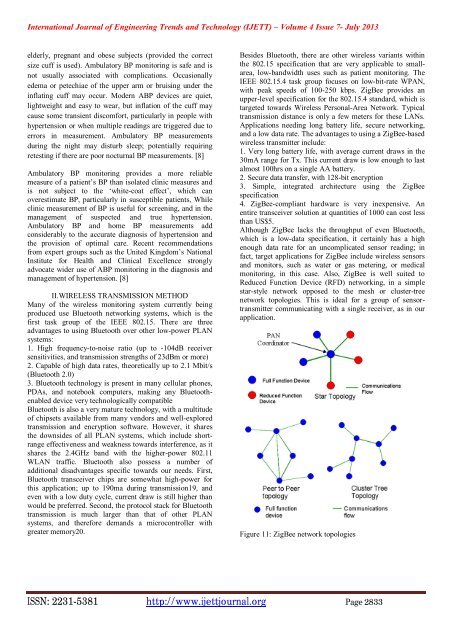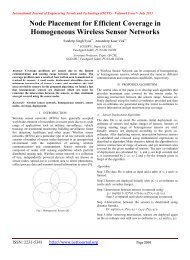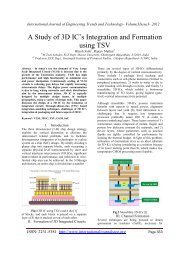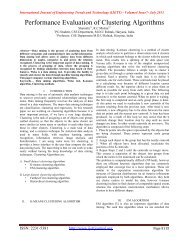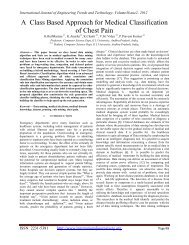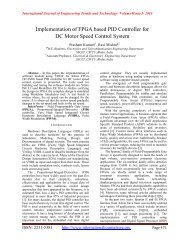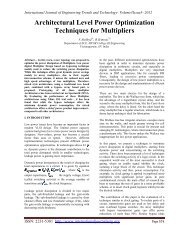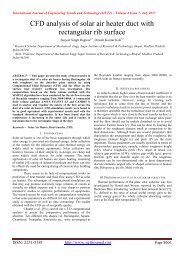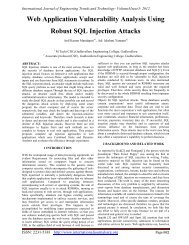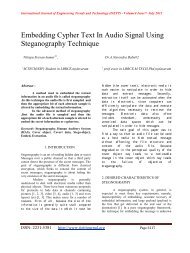Ambulatory Monitoring System - IJETT-International Journal of ...
Ambulatory Monitoring System - IJETT-International Journal of ...
Ambulatory Monitoring System - IJETT-International Journal of ...
Create successful ePaper yourself
Turn your PDF publications into a flip-book with our unique Google optimized e-Paper software.
<strong>International</strong> <strong>Journal</strong> <strong>of</strong> Engineering Trends and Technology (<strong>IJETT</strong>) – Volume 4 Issue 7- July 2013elderly, pregnant and obese subjects (provided the correctsize cuff is used). <strong>Ambulatory</strong> BP monitoring is safe and isnot usually associated with complications. Occasionallyedema or petechiae <strong>of</strong> the upper arm or bruising under theinflating cuff may occur. Modern ABP devices are quiet,lightweight and easy to wear, but inflation <strong>of</strong> the cuff maycause some transient discomfort, particularly in people withhypertension or when multiple readings are triggered due toerrors in measurement. <strong>Ambulatory</strong> BP measurementsduring the night may disturb sleep; potentially requiringretesting if there are poor nocturnal BP measurements. [8]<strong>Ambulatory</strong> BP monitoring provides a more reliablemeasure <strong>of</strong> a patient’s BP than isolated clinic measures andis not subject to the ‘white-coat effect’, which canoverestimate BP, particularly in susceptible patients, Whileclinic measurement <strong>of</strong> BP is useful for screening, and in themanagement <strong>of</strong> suspected and true hypertension.<strong>Ambulatory</strong> BP and home BP measurements addconsiderably to the accurate diagnosis <strong>of</strong> hypertension andthe provision <strong>of</strong> optimal care. Recent recommendationsfrom expert groups such as the United Kingdom’s NationalInstitute for Health and Clinical Excellence stronglyadvocate wider use <strong>of</strong> ABP monitoring in the diagnosis andmanagement <strong>of</strong> hypertension. [8]II.WIRELESS TRANSMISSION METHODMany <strong>of</strong> the wireless monitoring system currently beingproduced use Bluetooth networking systems, which is thefirst task group <strong>of</strong> the IEEE 802.15. There are threeadvantages to using Bluetooth over other low-power PLANsystems:1. High frequency-to-noise ratio (up to -104dB receiversensitivities, and transmission strengths <strong>of</strong> 23dBm or more)2. Capable <strong>of</strong> high data rates, theoretically up to 2.1 Mbit/s(Bluetooth 2.0)3. Bluetooth technology is present in many cellular phones,PDAs, and notebook computers, making any Bluetoothenableddevice very technologically compatibleBluetooth is also a very mature technology, with a multitude<strong>of</strong> chipsets available from many vendors and well-exploredtransmission and encryption s<strong>of</strong>tware. However, it sharesthe downsides <strong>of</strong> all PLAN systems, which include shortrangeeffectiveness and weakness towards interference, as itshares the 2.4GHz band with the higher-power 802.11WLAN traffic. Bluetooth also possess a number <strong>of</strong>additional disadvantages specific towards our needs. First,Bluetooth transceiver chips are somewhat high-power forthis application; up to 190ma during transmission19, andeven with a low duty cycle, current draw is still higher thanwould be preferred. Second, the protocol stack for Bluetoothtransmission is much larger than that <strong>of</strong> other PLANsystems, and therefore demands a microcontroller withgreater memory20.Besides Bluetooth, there are other wireless variants withinthe 802.15 specification that are very applicable to smallarea,low-bandwidth uses such as patient monitoring. TheIEEE 802.15.4 task group focuses on low-bit-rate WPAN,with peak speeds <strong>of</strong> 100-250 kbps. ZigBee provides anupper-level specification for the 802.15.4 standard, which istargeted towards Wireless Personal-Area Network. Typicaltransmission distance is only a few meters for these LANs.Applications needing long battery life, secure networking,and a low data rate. The advantages to using a ZigBee-basedwireless transmitter include:1. Very long battery life, with average current draws in the30mA range for Tx. This current draw is low enough to lastalmost 100hrs on a single AA battery.2. Secure data transfer, with 128-bit encryption3. Simple, integrated architecture using the ZigBeespecification4. ZigBee-compliant hardware is very inexpensive. Anentire transceiver solution at quantities <strong>of</strong> 1000 can cost lessthan US$5.Although ZigBee lacks the throughput <strong>of</strong> even Bluetooth,which is a low-data specification, it certainly has a highenough data rate for an uncomplicated sensor reading; infact, target applications for ZigBee include wireless sensorsand monitors, such as water or gas metering, or medicalmonitoring, in this case. Also, ZigBee is well suited toReduced Function Device (RFD) networking, in a simplestar-style network opposed to the mesh or cluster-treenetwork topologies. This is ideal for a group <strong>of</strong> sensortransmittercommunicating with a single receiver, as in ourapplication.Figure 11: ZigBee network topologiesISSN: 2231-5381 http://www.ijettjournal.org Page 2833


